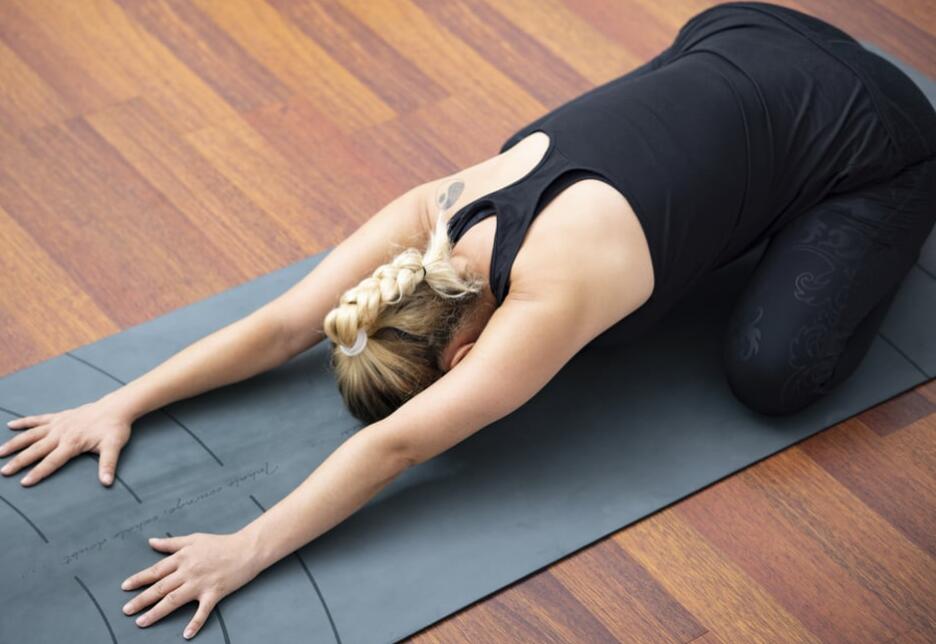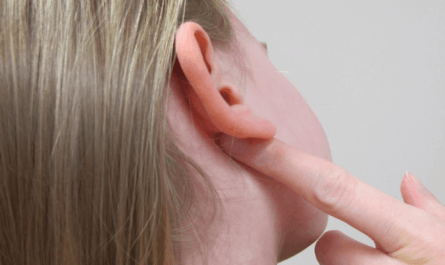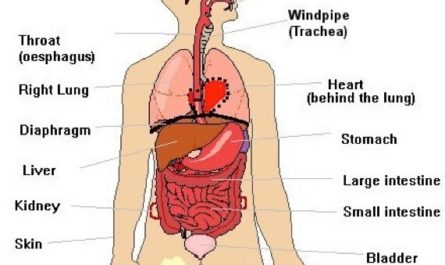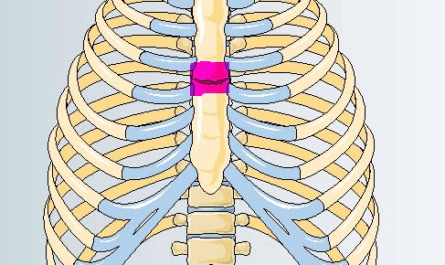Are you experiencing a nagging pain under your right shoulder blade? The right shoulder blade, also known as the right scapula, is a triangular-shaped bone that connects your upper arm to your collarbone and spine. This discomfort can range from a dull ache to a sharp, stabbing sensation. It can be caused by a variety of factors, from poor posture to serious underlying health conditions. This article will explore the 14 causes of pain under the right shoulder blade with effective natural remedies.

14 Causes of Pain Under My Right Shoulder Blade
1. Poor Posture
One of the most common causes of pain under the right shoulder blade is poor posture. In today’s world, many of us spend hours hunched over computers, smartphones, or tablets. This can lead to muscle strain and imbalances. When you slouch or round your shoulders, you put extra stress on the muscles and joints in your right shoulder blade.
To prevent posture-related pain, make a conscious effort to sit and stand up straight. Keep your shoulders back and down, your chin tucked, and your ears in line with your shoulders.
If you work at a desk, ensure that your computer screen is at eye level. In addition, taking regular breaks to stretch and move around can also help alleviate muscle tension and prevent pain.
2. Muscle Strain
Muscle strain is another common cause of pain under the right shoulder blade. This can occur due to overuse, improper lifting techniques, or sudden movements. Athletes, manual laborers, and individuals who engage in repetitive overhead motions are particularly susceptible to muscle strains.
If you suspect a muscle strain, rest is crucial. Avoid activities that aggravate your pain and apply ice to the affected area for 15-20 minutes at a time, several times a day. Over-the-counter pain medications, such as ibuprofen or acetaminophen, can help manage discomfort.
3. Rotator Cuff Injury
The rotator cuff is a group of four muscles and tendons that stabilize your shoulder joint and allow for a wide range of motion. Injuries to the rotator cuff, such as tears or tendinitis, can cause pain that radiates from your shoulder to your upper back.
Rotator cuff injuries are common among athletes who engage in repetitive overhead motions, such as swimmers, tennis players, and baseball pitchers. Age-related wear and tear can also contribute to rotator cuff problems. Treatment may include rest, physical therapy, and in severe cases, surgery.
4. Gallbladder Issues
Your gallbladder is a small, pear-shaped organ located beneath your liver on the right side of your abdomen. Gallbladder problems, such as gallstones or inflammation (cholecystitis), can cause referred pain under the right shoulder blade.
Other symptoms of gallbladder issues may include:
- Abdominal pain, particularly in the upper right quadrant
- Nausea and vomiting
- Fever and chills
- Jaundice (yellowing of the skin and eyes)
If you experience these symptoms, seek medical attention promptly. Treatment for gallbladder problems may involve lifestyle changes, medications, or surgery.
5. Liver Problems
The liver, the largest internal organ in your body, is located on the right side of your abdomen, just below your diaphragm. Liver problems, such as hepatitis, cirrhosis, or liver cancer, can cause pain that radiates to the area under your right shoulder blade.
Other signs of liver problems may include:
- Abdominal pain and swelling
- Fatigue
- Unexplained weight loss
- Dark urine and pale stools
- Jaundice
If you suspect a liver issue, consult your healthcare provider. Treatment will depend on the specific condition and may include lifestyle changes, medications, or surgery.

6. Acid Reflux or GERD
Acid reflux is also known as gastroesophageal reflux disease (GERD). It occurs when stomach acid flows back into your esophagus, causing irritation and inflammation. While most people associate acid reflux with heartburn, it can also cause referred pain under the right shoulder blade.
Other symptoms of acid reflux may include:
- Chest pain
- Difficulty swallowing
- Regurgitation of food or sour liquid
- Chronic cough or wheezing
To manage acid reflux, try eating smaller, more frequent meals, and avoiding trigger foods (such as spicy or fatty foods). Over-the-counter antacids or prescription medications may also help alleviate symptoms.
7. Pleurisy
Pleurisy is an inflammation of the pleura, the thin membrane that lines the inside of your chest cavity and surrounds your lungs. This condition can cause sharp, stabbing pain in your chest that may radiate to the area under your right shoulder blade.
Pleurisy can be caused by a variety of factors, including:
- Viral or bacterial infections
- Autoimmune disorders, such as lupus or rheumatoid arthritis
- Lung cancer or metastatic cancer
- Pulmonary embolism (blood clot in the lungs)
Treatment for pleurisy depends on the underlying cause and may include antibiotics, anti-inflammatory medications, or surgery.
8. Pneumonia
Pneumonia is an infection that inflames the air sacs in one or both lungs, causing them to fill with fluid or pus. This condition can cause a range of symptoms, including chest pain that may radiate to the area under your right shoulder blade.
Other signs of pneumonia may include:
- Cough with phlegm or pus
- Fever and chills
- Shortness of breath
- Fatigue
- Nausea and vomiting
If you suspect pneumonia, seek medical attention. Treatment typically involves antibiotics, rest, and plenty of fluids.

9. Shingles
Shingles is a viral infection caused by the varicella-zoster virus, the same virus that causes chickenpox. If you’ve had chickenpox, the virus can lie dormant in your nerve tissue for years before reactivating as shingles.
This condition causes a painful, blistering rash that typically appears on one side of your body. It often wraps around from your back to your chest.
If you suspect shingles, contact your healthcare provider. Early treatment with antiviral medications can help shorten the duration of the illness.
10. Cervical Spondylosis
Cervical spondylosis is an age-related condition that involves wear and tear on the vertebrae, discs, and joints in your neck. As these structures deteriorate, they can put pressure on the nerves that run from your neck to your shoulders and arms. This can cause pain that may radiate to the area under your right shoulder blade.
Other symptoms of cervical spondylosis may include:
- Neck pain and stiffness
- Headaches
- Numbness or weakness in your arms or hands
- Difficulty walking or maintaining balance
Treatment for cervical spondylosis may include physical therapy, pain medications, or surgery in severe cases.
11. Thoracic Outlet Syndrome
Thoracic outlet syndrome (TOS) is a group of disorders. It occurs when blood vessels or nerves in the space between your collarbone and your first rib become compressed. This can cause pain in your shoulders and neck, as well as numbness and tingling in your fingers.
In some cases, TOS can cause referred pain under the right shoulder blade. Other symptoms may include:
- Weakness in your hand and arm
- Cold sensitivity in your hands and fingers
- Swelling or discoloration in your arm
Treatment for TOS may include physical therapy, medications, or surgery, depending on the severity of the condition.
12. Pancoast Tumor
A Pancoast tumor is a rare type of lung cancer that grows at the top of the lung, near the spine, and the nerves that run from the upper chest to the arm. These tumors can cause pain under the right shoulder blade, as well as other symptoms such as:
- Arm and hand pain, numbness, or weakness
- Horner’s syndrome (drooping eyelid, small pupil, and decreased sweating on one side of the face)
- Swelling in the upper arm or face
If you experience these symptoms, consult your healthcare provider. Treatment for Pancoast tumors typically involves a combination of radiation therapy, chemotherapy, and surgery.

13. Referred Pain from Heart or Lung Issues
In some cases, pain under the right shoulder blade may be referred to as problems with your heart or lungs. For example, a heart attack or pericarditis can cause pain that radiates to your shoulder blades.
Similarly, lung conditions such as a collapsed lung or pulmonary hypertension can cause referred pain in the upper back and shoulder area.
If you experience pain under your right shoulder blade accompanied by chest pain, shortness of breath, or other concerning symptoms, seek emergency medical attention.
14. Fibromyalgia
Fibromyalgia is a chronic condition characterized by widespread musculoskeletal pain, fatigue, and tenderness in specific points on the body. While the exact cause of fibromyalgia is unknown, it is thought to involve changes in the way the brain and nervous system process pain signals.
Pain under the right shoulder blade is a common complaint among individuals with fibromyalgia. Other symptoms may include:
- Fatigue and sleep disturbances
- Memory and concentration problems (“fibro fog”)
- Headaches
- Digestive issues
Treatment for fibromyalgia typically involves a combination of medications, lifestyle changes, and therapies such as exercise, cognitive-behavioral therapy, and stress management techniques.

6 Home Remedies for Pain Under My Right Shoulder Blade
1. Stretching and Gentle Exercises
One of the most effective ways to relieve pain under the right shoulder blade is through stretching and gentle exercises. These movements can help loosen tight muscles, improve flexibility, and promote better posture. Try the following stretches:
- Shoulder Blade Squeeze: Sit or stand up straight, and gently squeeze your shoulder blades together. Hold for 5-10 seconds, then release. Repeat 10 times.
- Neck Rolls: Slowly roll your head in a circular motion, starting from your chin to your chest, then to your left shoulder, back, and right shoulder. Repeat 5 times in each direction.
- Corner Stretch: Stand facing a corner, with your hands on the walls at shoulder height. Lean forward until you feel a gentle stretch in your chest and shoulders. Hold for 15-30 seconds, then release.
2. Heat Therapy
Applying heat to the affected area can help relax tense muscles, improve blood flow, and reduce pain. There are several ways to use heat therapy for pain under the right shoulder blade:
- Warm Compress: Apply a warm compress or heating pad to the painful area for 15-20 minutes at a time, several times a day. Be sure to wrap the compress in a towel to protect your skin from direct heat.
- Warm Bath or Shower: Take a warm bath or shower, focusing the water stream on your upper back and shoulders. The heat can help soothe your muscles and promote relaxation.
- Heat Wraps: Use adhesive heat wraps, which are available at most drugstores, to provide continuous, low-level heat to the affected area. These wraps can be worn under clothing and are particularly helpful for individuals with chronic pain.
When using heat therapy, be cautious not to apply excessive heat, as this can cause burns or skin irritation.
3. Cold Therapy
In some cases, cold therapy may be more effective than heat for relieving pain under the right shoulder blade. Cold can help reduce inflammation, numb pain, and constrict blood vessels to minimize swelling. Try the following cold therapy techniques:
- Cold Compress: Apply a cold pack or bag of frozen vegetables wrapped in a towel to the painful area for 15-20 minutes at a time, several times a day.
- Ice Massage: Freeze water in a paper cup, then peel back the top of the cup to expose the ice. Gently massage the affected area with the ice for 5-10 minutes, or until the area feels numb.
As with heat therapy, be cautious not to apply ice directly to your skin, as this can cause frostbite or tissue damage.
4. Massage
Massaging the area under your right shoulder blade can help alleviate muscle tension, improve circulation, and reduce pain. You can try self-massage techniques or enlist the help of a partner or professional massage therapist. Here are some massage techniques to try:
- Kneading: Using your fingertips or knuckles, gently knead the muscles under your right shoulder blade, working in circular motions. Focus on any areas that feel particularly tense or painful.
- Trigger Point Massage: Locate any tender, tight knots in your muscles (trigger points) and apply direct pressure with your fingers or a massage tool. Hold the pressure for 30-60 seconds, or until you feel the muscle relax.
- Foam Rolling: Use a foam roller to massage your upper back and shoulders. Lie on your back with the foam roller positioned under your shoulder blades, and gently roll back and forth, focusing on any tender areas.
5. Posture Correction
Poor posture is a common cause of pain under the right shoulder blade. Slouching, hunching over a desk, or carrying heavy bags can put unnecessary strain on your muscles and joints. To improve your posture and alleviate pain, try the following tips:
- Sit Up Straight: When sitting, keep your back straight, your shoulders back, and your feet flat on the floor. Use a lumbar support cushion if needed to maintain the natural curve of your lower back.
- Adjust Your Workstation: Ensure that your computer screen is at eye level, and your keyboard and mouse are positioned to allow your elbows to rest at a 90-degree angle. Use an ergonomic chair that supports your back and encourages good posture.
- Take Frequent Breaks: If you spend long hours sitting or standing, take regular breaks to stretch, walk around, and relieve muscle tension. Set a reminder on your phone or computer to prompt you to take breaks throughout the day.
6. Yoga and Pilates
Yoga and Pilates are gentle, low-impact forms of exercise that can help improve flexibility, strengthen muscles, and reduce pain under the right shoulder blade.
These practices focus on proper alignment, breathing, and body awareness, which can contribute to better posture and overall well-being. Try incorporating the following yoga poses or Pilates exercises into your routine:
- Cat-Cow Stretch: Start on your hands and knees, with your wrists under your shoulders and your knees under your hips. As you inhale, arch your back and look up (Cow pose). As you exhale, round your back and tuck your chin to your chest (Cat pose). Repeat 5-10 times.
- Thread-the-Needle Pose: Start on your hands and knees. Slide your right arm underneath your left arm, resting your right shoulder and side of your head on the floor. Hold for 5-10 breaths, then repeat on the other side.
- Pilates Swan Dive: Lie on your stomach with your hands under your shoulders. As you inhale, press your hands onto the floor and lift your head, chest, and arms off the ground. As you exhale, lower back down. Repeat 5-10 times.
When to Seek Medical Attention?
While many causes of pain under the right shoulder blade are not life-threatening, it’s essential to seek medical attention if your pain is severe, persistent, or accompanied by other concerning symptoms. Contact your healthcare provider if you experience:
- Pain that does not improve with rest or over-the-counter pain medications
- Pain that interferes with your daily activities or sleep
- Swelling, redness, or warmth in the affected area
- Chest pain, shortness of breath, or dizziness
- Unexplained weight loss or fatigue
- Numbness, tingling, or weakness in your arm or hand






